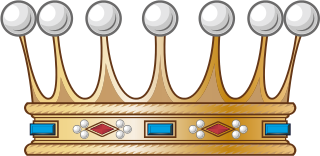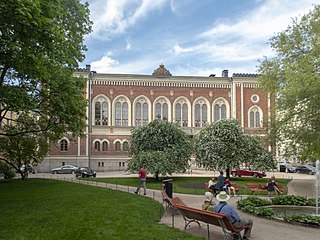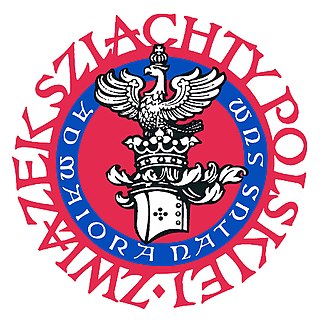Related Research Articles

Prince Henrik of Denmark was the husband of Margrethe II of Denmark. He served as her royal consort from Margrethe's accession on 14 January 1972 until his death in 2018.

Riksdag of the Estates was the name used for the Estates of Sweden when they were assembled. Until its dissolution in 1866, the institution was the highest authority in Sweden next to the King. It was a Diet made up of the Four Estates, which historically were the lines of division in Swedish society:

The Swedish nobility has historically been a legally and/or socially privileged class in Sweden, and part of the so-called frälse. The archaic term for nobility, frälse, also included the clergy, a classification defined by tax exemptions and representation in the diet. Today the nobility does not maintain its former legal privileges although family names, titles and coats of arms are still protected. The Swedish nobility consists of both "introduced" and "unintroduced" nobility, where the latter has not been formally "introduced" at the House of Nobility (Riddarhuset). The House of Nobility still maintains a fee for male members over the age of 18 for upkeep on pertinent buildings in Stockholm.
This glossary of the French Revolution generally does not explicate names of individual people or their political associations; those can be found in List of people associated with the French Revolution.

Freiherr, Freifrau and Freiin are designations used as titles of nobility in the German-speaking areas of the Holy Roman Empire and in its various successor states, including Austria, Prussia, Bavaria, Liechtenstein, Luxembourg, etc. Traditionally, it denotes the titled rank within the nobility above Ritter (knight) and Edler and below Graf. The title superseded the earlier medieval form, Edelherr.
Traditional rank amongst European royalty, peers, and nobility is rooted in Late Antiquity and the Middle Ages. Although they vary over time and among geographic regions, the following is a reasonably comprehensive list that provides information on both general ranks and specific differences. Distinction should be made between reigning families and the nobility – the latter being a social class subject to and created by the former.

The House of Nobility in Stockholm, Sweden, is a corporation and a building that maintains records and acts as an interest group on behalf of the Swedish nobility.

The Model European Parliament (MEP) is an international simulation of the working of the European Parliament for students aged 16–19. The aim of the programme is to give young people an insight into the workings of the European Parliament and raise their awareness of European citizenship. Two sessions are held each year, each involving 180 secondary school students.

The French nobility was a privileged social class in France from the Middle Ages until its abolition on 23 June 1790 during the French Revolution.

Croatian nobility was a privileged social class in Croatia during the Antiquity and Medieval periods of the country's history. Noble families in the Kingdom of Croatia included high ranking populates from Slavonia, Dalmatia, Istria, and Republic of Ragusa. Members belonged to an elite social hierarchy, normally placed immediately behind blood royalty, that possessed considerably more privileges or eminence than most other classes in a society. Membership thereof typically was often hereditary. Historically, membership in the nobility and the prerogatives thereof have been regulated or acknowledged by the monarch. Acquisition of sufficient power, wealth, military prowess or royal favour enabled commoners to ascend into the nobility. The country's royalty was heavily influenced by France's nobility resulting members of the Royal Courts to assume French titles and practices during French occupation. The controversial assumption of French practices contributed to wide spread political and social elitism among the nobles and monarch. The nobility regarded the peasant class as an unseen and irrelevant substrata of people which lead to high causality revolts and beheadings as well as sporadic periods of intense domestic violence.

The House of Nobility either refers to the institution of the Finnish nobility or the palace of the noble estate. The Finnish nobility was from 1809 until 1906 the first of the four estates of the realm.
The British nobility is made up of the peerage and the (landed) gentry. The nobility of its four constituent home nations has played a major role in shaping the history of the country, although the hereditary peerage now retain only the rights to stand for election to the House of Lords, dining rights there, position in the formal order of precedence, the right to certain titles, and the right to an audience with the monarch. More than a third of British land is in the hands of aristocrats and traditional landed gentry.

The House of Monpezat is a French old bourgeois family from the Province of Béarn associated with the Danish Royal Family by marriage after 1967, when Henri de Laborde de Monpezat wed Princess Margrethe of Denmark, then the heir presumptive of the ruling House of Glücksburg, who was subsequently the Queen of Denmark as Margrethe II. The current Danish monarch, King Frederik X is agnatically a Monpezat.
A heraldic authority is defined as an office or institution which has been established by a reigning monarch or a government to deal with heraldry in the country concerned. It does not include private societies or enterprises which design and/or register coats of arms. Over the centuries, many countries have established heraldic authorities, and several still flourish today.

The Polish Nobility Association (PNA) – is a sociocultural organization, registered in 1995 in Gdańsk. The association aims to integrate the nobility of the once Polish–Lithuanian Commonwealth, take care of cultural monuments of the nobles, popularize the history and traditions of the Polish nobility, szlachta, and promote the ethos of chivalry.

Nobility is a social class found in many societies that have an aristocracy. It is normally ranked immediately below royalty. Nobility has often been an estate of the realm with many exclusive functions and characteristics. The characteristics associated with nobility may constitute substantial advantages over or relative to non-nobles or simply formal functions, and vary by country and by era. Membership in the nobility, including rights and responsibilities, is typically hereditary and patrilineal.
The Corpo della nobiltà italiana, sometimes referred to as CNI, is a private association established in 1957 to protect heraldic and nobility rights of Italian nobles after the republican constitution put an end to official recognition of nobility and noble titles.

Count of Monpezat, or Countess of Monpezat when the holder is female, is a hereditary title of Danish nobility. It was granted on 30 April 2008 by Queen Margrethe II to her two sons, Crown Prince Frederik and Prince Joachim, and their legitimate patrilineal (male-line) descendants of both sexes. The title is derived from the French title of "comte de Laborde de Monpezat", which was used by Frederik and Joachim's father, Prince Henrik.